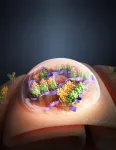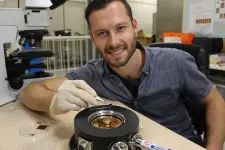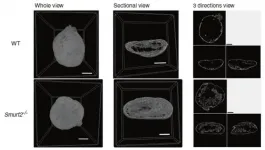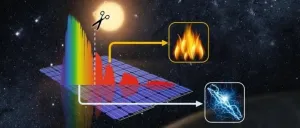(Press-News.org) DALLAS - Feb. 8, 2021 - A new nanoparticle-based drug can boost the body's innate immune system and make it more effective at fighting off tumors, researchers at UT Southwestern have shown. Their study, published in Nature Biomedical Engineering, is the first to successfully target the immune molecule STING with nanoparticles about one millionth the size of a soccer ball that can switch on/off immune activity in response to their physiological environment.
"Activating STING by these nanoparticles is like exerting perpetual pressure on the accelerator to ramp up the natural innate immune response to a tumor," says study leader Jinming Gao, Ph.D., a professor in UT Southwestern's Harold C. Simmons Comprehensive Cancer Center and a professor of otolaryngology - head and neck surgery, pharmacology, and cell biology.
For more than a decade, researchers and pharmaceutical companies have been racing to develop drugs that target STING, which stands for "stimulator of interferon genes." The STING protein, discovered in 2008, helps mediate the body's innate immune system - the collection of immune molecules that act as first responders when a foreign agent circulates in the body, including cancer DNA. Research has suggested that activating STING can make the innate immune system more powerful at fighting tumors or infections. However, results from earlier clinical trials involving first-generation compounds targeting STING for activation failed to demonstrate an impressive clinical effect.
"A major limitation of conventional small molecule drugs is that after injection into tumors, they are washed out from the tumor site by blood perfusion, which can reduce antitumor efficacy while causing systemic toxicities," explains Gao.
Gao and his colleagues at UTSW discovered another approach that is different from the earlier or first-generation STING agonist approaches that utilize synthetic cyclic dinucleotide to activate STING in the body. Gao and his team aimed to design a polymer - a manmade macromolecule that can self-assemble into nanoparticles - to effectively deliver cyclic GMP-AMP (cGAMP), a natural small molecule activator of STING, to the protein target. But one polymer they synthesized, PC7A, produced an unexpected and novel effect: It activated STING even without cGAMP. The group reported the initial results in 2017, not knowing at the time exactly how PC7A worked; the polymer didn't resemble any other drugs that activated STING.
In the new paper, Gao's team showed that PC7A binds to a different site on the STING molecule from known drugs. Moreover, its effect on the STING protein is different. While existing drugs activate the protein over the course of about six hours, PC7A forms polyvalent condensates with STING for over 48 hours, causing a more sustained effect on STING. This longer innate immune activation, they showed, leads to a more effective T cell response against multiple solid tumors. Mice survived longer and had slower tumor growth when they received a combination of PC7A and cGAMP, the researchers found.
The polymer also has other advantages. When circulating in the bloodstream, the polymers are present as small round nanoparticles that do not bind to STING. It's only when those nanoparticles enter immune cells that they separate, attach to STING, and activate the immune response. That means that PC7A might be less likely to cause side effects throughout the body than other STING-targeting drugs, says Gao, although clinical trials will be needed to prove that.
Because PC7A binds to a different site of the STING molecule, the compound might work in patients for whom typical STING-targeting drugs do not. Up to 20 percent of people have inherited a slightly different gene for STING; the variant makes the STING protein resistant to several cyclic dinucleotide drugs. Gao and his team demonstrated that PC7A can still activate cells that express these STING variants.
"There's been a lot of excitement about therapies that target STING and the potential role these compounds could play in expanding the benefits of immunotherapies for cancer patients," says Gao. "We believe that our new nanotechnology approach offers a way to activate STING without some of the limitations we've seen with earlier STING agonist drugs in development."
INFORMATION:
Other UTSW researchers who contributed to this study were Suxin Li, Min Luo, Zhaohui Wang, Qiang Feng, Jonathan Wilhelm, Xu Wang, Wei Li, Jian Wang, Agnieszka Cholka, Yang-xin Fu, Baran Sumer, and Hongtao Yu.
This research was supported by funds from the National Institutes of Health (U54 CA244719) and Mendelson-Young Endowment for Cancer Therapeutics.
Gao holds the Elaine Dewey Sammons Distinguished Chair in Cancer Research, in honor of Eugene P. Frenkel, M.D. at UTSW.
AURORA, Colo. (February 8, 2021) - Researchers from the Barbara Davis Center for Childhood Diabetes at the University of Colorado Anschutz Medical Campus have found that immune responses to insulin could help identify individuals most at risk for developing Type 1 diabetes.
The study, out recently in the Proceedings of the National Academy of Sciences, measured immune responses from individuals genetically predisposed to developing Type 1 diabetes (T1D) to naturally occurring insulin and hybrid insulin peptides. Since not all genetically predisposed individuals ...
An international team of scientists has invented the equivalent of body armour for extremely fragile quantum systems, which will make them robust enough to be used as the basis for a new generation of low-energy electronics.
The scientists applied the armour by gently squashing droplets of liquid metal gallium onto the materials, coating them with gallium oxide.
Protection is crucial for thin materials such as graphene, which are only a single atom thick - essentially two-dimensional (2D) - and so are easily damaged by conventional layering technology, said Matthias Wurdack, who is the lead author of the group's publication in Advanced Materials.
"The protective coating ...
A framework designed to provide detailed information on agricultural groundwater use in arid regions has been developed by KAUST researchers in collaboration with the Saudi Ministry of Environment Water and Agriculture (MEWA).
"Groundwater is a precious resource, but we don't pay for it to grow our food, we just pump it out," says Oliver López, who worked on the project with KAUST's Matthew McCabe and co-workers. "When something is free, we are less likely to keep track of it, but it is critical that we measure groundwater extraction because it impacts both food and water security, not just regionally, but globally."
Saudi Arabia's farmland is often irrigated via center pivots that tap underground aquifer sources. The team has built a powerful tool ...
Osaka, Japan - Bone morphogenetic protein (BMP) has a strong osteogenic (bone forming) ability. BMP has already been clinically applied to spinal fusion and non-union fractures. However, dose-dependent side effects related to BMP use, such as inflammatory reactions at the administration site, prevent widespread use.
For safe use, it was necessary to clarify how the BMP signaling pathway is controlled. In a report published in Bone Research, a group of researchers from Osaka University and Ehime University has recently identified a novel role for the protein Smurf2 in regulating bone formation by BMP.
When BMP transmits its message within cells, it can induce rapid bone formation. Previous studies have shown that Smurf2 can control another similar ...
Lithium metal batteries could double the amount of energy held by lithium-ion batteries, if only their anodes didn't break down into small pieces when they were used.
Now, researchers led by Prof. CUI Guanglei from the Qingdao Institute of Bioenergy and Bioprocess Technology (QIBEBT) of the Chinese Academy of Sciences (CAS) have identified what causes lithium metal batteries (LMBs) to "self-destruct" and proposed a way to prevent it. The findings were published in Angewandte Chemie on Jan. 19.
This offers hope of radically enhancing the energy held in batteries without any increase in their size, and at reduced cost.
In fact, LMBs were the original concept for long-lasting ...
Tiny nanoparticles can be furnished with dyes and could be used for new imaging techniques, as chemists and physicists at Martin Luther University Halle-Wittenberg (MLU) show in a recent study. The researchers have also been the first to fully determine the particles' internal structure. Their results were published in the renowned journal Angewandte Chemie.
Single-chain nanoparticles (SCNPs) are an attractive material for chemical and biomedical applications. They are created from just a single chain of molecules that folds into a particle whose circumference measures three to five nanometres. "Because they are so small, they can travel everywhere in the human body and be used for a wide variety of purposes," says Professor Wolfgang ...
In humans, differences in personalities have been evident since the ancient times. Personality in animals has long been ignored, but recently this question has received increasing research interest as it has been realized that personality has evolutionary and ecological significance. An international team of behavioral biologists from Austria, Brazil and the Netherlands, with Vedrana Å lipogor from the University of Vienna as leading author of the study, designed a set of tasks to assess personality of common marmosets. These results have just been published in American Journal of Primatology.
Marmosets are small highly social New World monkeys that parallel humans in their social organization, as they live in cohesive ...
Researchers from the Institute of Environmental Science and Technology of the Universitat Autònoma de Barcelona (ICTA-UAB) warn of the impact the current tourism model in the Mediterranean islands has on the production of marine litter on beaches, and recommend taking advantage of the situation generated by the Covid19 pandemic to rethink a new more sustainable model. The research, recently published in the journal Scientific Reports, shows that the recreational use of Mediterranean island beaches during the summer is responsible for up to 80% of the marine litter accumulating on those beaches, and generates huge amounts of microplastics through the fragmentation ...
A German-Chinese research team has found a new synthetic route to produce biofuel from biomass. The chemists converted the substance 5-hydroxymethylfurfural (HMF) produced from biomass into 2,5-dimethylfuran (DMF), which could be suitable as a biofuel. Compared to previous methods, they achieved a higher yield and selectivity under milder reaction conditions. The team led by Dr. Baoxiang Peng and Professor Martin Muhler from the Laboratory of Industrial Chemistry at Ruhr-Universität Bochum (RUB) and the group led by Professor Christof Hättig from the RUB Chair for Theoretical Chemistry described the method together with colleagues from Changzhou, ...
Solar energy is one of the most abundant renewable energy sources, and effective solar technologies have great potential to alleviate the grand challenges of rising global energy demands, while reducing associated emissions. Solar energy is capable of satisfying the electrical and thermal-energy needs of diverse end-users by means of photovoltaic (PV) and solar thermal (ST) technologies, respectively. Recently, hybrid photovoltaic-thermal (PVT) concepts have been proposed that synergistically combine the benefits of PV and ST technologies, and are capable of generating both electricity and useful heat simultaneously from the same area and component.
Spectral splitting is an emerging approach for designing high-performance PVT solar collectors, which employ advanced designs ...






